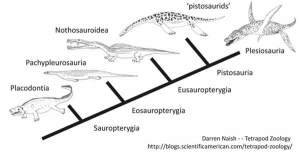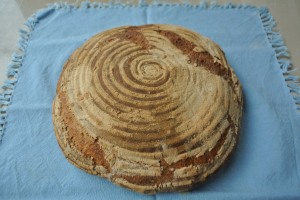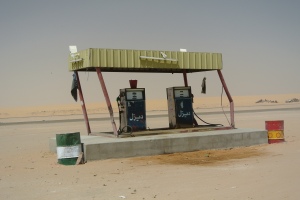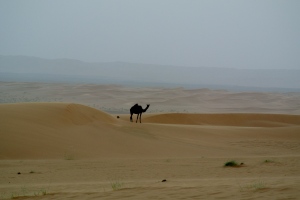 It’s finally here, after the big build up. Would it start on Saturday? Would it start on Sunday? The ninth month of the Islamic lunar calendar is the month for fasting during daylight hours. It is called Ramadan. It is the time when Muhammad was revealed the first sentences of the Koran. It is a time for reflection, charity and good thoughts. The start of the fast and the lunar month is dictated by the first sight of the new moon, a tiny slither of moon that can be just seen on the horizon as the sun sets. In Saudi Arabia, a prize is awarded to the first person who spots the moon, authenticated by experts. Until the middle of last week everyone thought that Ramadan would begin on Saturday, but as the moon was not spotted at Friday sunset it began on Sunday.
It’s finally here, after the big build up. Would it start on Saturday? Would it start on Sunday? The ninth month of the Islamic lunar calendar is the month for fasting during daylight hours. It is called Ramadan. It is the time when Muhammad was revealed the first sentences of the Koran. It is a time for reflection, charity and good thoughts. The start of the fast and the lunar month is dictated by the first sight of the new moon, a tiny slither of moon that can be just seen on the horizon as the sun sets. In Saudi Arabia, a prize is awarded to the first person who spots the moon, authenticated by experts. Until the middle of last week everyone thought that Ramadan would begin on Saturday, but as the moon was not spotted at Friday sunset it began on Sunday.
To be in Saudi Arabia, the center of the Muslim world, during Ramadan is certainly a different experience. The run up to the month has been eye opening. Think shops at Thanks Giving in the USA and Christmas in the UK, then add in an American Nor’easter prediction and you can start imagining what the grocery stores are like. The Saudi Gazette recently published forecasts by the SAMA (Saudi Arabian Monetary Agency) that household spending in June and July is expected to reach an eye watering SAR 724 billion, (approximately US $183 billion) Even the Grand Mufti has voiced his disquiet at the contrast between this consumerism and a month of fasting and restraint — it sounds reminiscent of the Archbishop of Canterbury condemning commercialism at Christmas.
I knew something about Ramadan before I came to the Kingdom, but I had only been exposed to it within a wider ranging culture. School friends who fasted, not always diligently, and other friends who were more circumspect. I had never visited a muslim country during Ramadan before. During the run up to Ramadan, the stock in the supermarkets changed. The aisles are crowded with vast pallets of un-familiar products. So much so that two trolleys cannot pass making the usual supermarket scramble a grid lock.  I wondered why anyone would want cases of Vimto (a sweet herbal fruit cordial), gallon containers of fortified powdered milk, (the dairies are good here), sacks of rice, big enough to feed a british family of four for a year, enormous bright orange containers of Tang. (Do you remember Tang? the 1970’s popular powdered drink you mix with water to make an orange drink that has probably never seen an orange). Along with vats of cooking oil on special offer, huge arrangements of tinned oats, not mention the dates and date products of every conceivable variety. Every market is bursting at the seams. On Friday the day before the beginning of Ramadan there was chaos at a Tamimi (one of supermarket chains here) with people literally charging the store because of their special offers. click here to see link!
I wondered why anyone would want cases of Vimto (a sweet herbal fruit cordial), gallon containers of fortified powdered milk, (the dairies are good here), sacks of rice, big enough to feed a british family of four for a year, enormous bright orange containers of Tang. (Do you remember Tang? the 1970’s popular powdered drink you mix with water to make an orange drink that has probably never seen an orange). Along with vats of cooking oil on special offer, huge arrangements of tinned oats, not mention the dates and date products of every conceivable variety. Every market is bursting at the seams. On Friday the day before the beginning of Ramadan there was chaos at a Tamimi (one of supermarket chains here) with people literally charging the store because of their special offers. click here to see link!  I shopped on the Thursday before Ramadan at a usually quiet time and even then most people had 3 trolleys full of food, including vast quantities of Vimto and Tang, trays of frozen chicken, sacks of rice, cooking oil etc, tinned soup. The queue for the check out went round the store. It felt as though people were battening down for a siege. All the grocery shops are open during Ramadan, but I think that people like to get ahead on their marketing as many people seem to sleep during the day if they don’t have to work. Everything shifts to a nocturnal schedule. Although some supermarkets are open during the day, most shops open for two hours between 4pm and 6.00pm, and then from 9.00pm till 1 or 2.00am. I went downtown Riyadh last night to one of the souks and it was teeming with people at 10.00pm and horrendous traffic jams.
I shopped on the Thursday before Ramadan at a usually quiet time and even then most people had 3 trolleys full of food, including vast quantities of Vimto and Tang, trays of frozen chicken, sacks of rice, cooking oil etc, tinned soup. The queue for the check out went round the store. It felt as though people were battening down for a siege. All the grocery shops are open during Ramadan, but I think that people like to get ahead on their marketing as many people seem to sleep during the day if they don’t have to work. Everything shifts to a nocturnal schedule. Although some supermarkets are open during the day, most shops open for two hours between 4pm and 6.00pm, and then from 9.00pm till 1 or 2.00am. I went downtown Riyadh last night to one of the souks and it was teeming with people at 10.00pm and horrendous traffic jams.
Muslims begin their daily fast at Fajr prayers which signal the beginning of dawn and end fasting at Maghrib prayers which signal sunset. During that time they cannot eat, smoke or drink, even water, which in this climate and during summer is very hard. During Ramadan it is against the law for non muslims to eat or drink in public. All restaurants are closed during the day. We can, of course, eat or drink in private and on compounds.
So I wanted to do some research into the products that people buy for Ramadan and what they are used for. The breaking of the fast is known as Iftar. It is a time when typically families get together to eat, and many families prepare a feast of food every night. Every family has its own traditions, but in common with the christmas some seem essential to every Iftar. The fast is usually broken with dates and water, before going to pray, after those prayers many people begin their Iftar although some families don’t begin their main meal until after Isha, which are the final prayers of the night. One Saudi friend explained to me that his family always ate desert first and then moved to the main course after Isha. Another Saudi explained what the main parts of the iftar normally include. The meal starts with a soup, often made with oats, there will also be beans or Ful which is bean type puree. Then there may be salads and houmous, but there will always be deep fried samosas, after that rice dishes, often served with boiled lamb, a chicken dish and then a selection of vegetables. This will be followed by fruit and many rich deserts which are made using the fortified powdered milk.  So where do the Vimto and Tang come in? They vie with each other to be the soft drink of choice for Iftar, with fierce price cutting wars every year. Vimto has been the Iftar drink of choice for the last 80 years, originally marketed as a health tonic in the UK , The sugary cordial has 90% of the cordial market in the middle east. Tang is manufactured by Kraft, the mega giant processed food manufacturer. The brand became synonymous in the Arabian Peninsula with tinned cheese, but they have manufactured Tang in different flavors since the 1960’s. Tang is Vimto’s most aggressive competitor for the “Iftar drink” and runs huge TV advertising campaigns to try and persuade people to break their fast with Tang. Although these drinks have managed a market penetration and association with Ramadan in the same way as Egg Nog has with Christmas, I feel rather the same way about all of them; To my taste they are over sweet and not very delicious.
So where do the Vimto and Tang come in? They vie with each other to be the soft drink of choice for Iftar, with fierce price cutting wars every year. Vimto has been the Iftar drink of choice for the last 80 years, originally marketed as a health tonic in the UK , The sugary cordial has 90% of the cordial market in the middle east. Tang is manufactured by Kraft, the mega giant processed food manufacturer. The brand became synonymous in the Arabian Peninsula with tinned cheese, but they have manufactured Tang in different flavors since the 1960’s. Tang is Vimto’s most aggressive competitor for the “Iftar drink” and runs huge TV advertising campaigns to try and persuade people to break their fast with Tang. Although these drinks have managed a market penetration and association with Ramadan in the same way as Egg Nog has with Christmas, I feel rather the same way about all of them; To my taste they are over sweet and not very delicious.






















